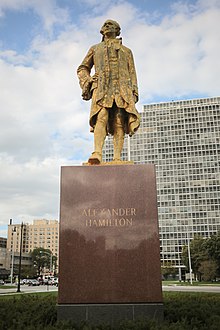
Grant Park is a large urban park in the Loop community area of Chicago, Illinois. Located within the city's central business district, the 319-acre (1.29 km2) park's features include Millennium Park, Buckingham Fountain, the Art Institute of Chicago, and the Museum Campus.
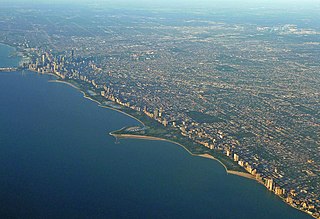
Lincoln Park is a 1,208-acre (489-hectare) park along Lake Michigan on the North Side of Chicago, Illinois. Named after US President Abraham Lincoln, it is the city's largest public park and stretches for seven miles (11 km) from Grand Avenue, on the south, to near Ardmore Avenue on the north, just north of the DuSable Lake Shore Drive terminus at Hollywood Avenue. Two museums and a zoo are located in the oldest part of the park between North Avenue and Diversey Parkway in the eponymous neighborhood. Further to the north, the park is characterized by parkland, beaches, recreational areas, nature reserves, and harbors. To the south, there is a more narrow strip of beaches east of Lake Shore Drive, almost to downtown. With 20 million visitors per year, Lincoln Park is the second-most-visited city park in the United States, behind Manhattan's Central Park.
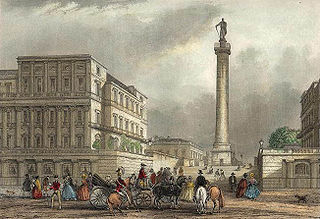
The Duke of York Column is a monument in London, England, to Prince Frederick, Duke of York, the second son of King George III. The designer was Benjamin Dean Wyatt. It is sited where a purposefully wide endpoint of Regent Street, known as Waterloo Place and Gardens, meets The Mall, between the two terraces of Carlton House Terrace and their tree-lined squares. The three very wide flights of steps down to The Mall adjoining are known as the Duke of York Steps. The column was completed in December 1832, and the statue of the Duke of York, by Sir Richard Westmacott, was raised on 10 April 1834.

The Alexander Column, also known as Alexandrian Column, is the focal point of Palace Square in Saint Petersburg, Russia. The monument was raised after the Russian victory in the war with Napoleon's France. The column is named for Emperor Alexander I of Russia, who reigned from 1801 to 1825.

The Bowman and The Spearman, also known collectively as Equestrian Indians, or simply Indians, are two bronze equestrian sculptures standing as gatekeepers in Congress Plaza, at the intersection of Ida B. Wells Drive and Michigan Avenue in Chicago's Grant Park, in the U.S. state of Illinois. The sculptures were made in Zagreb by Croatian sculptor Ivan Meštrović and installed at the entrance of the parkway in 1928. Funding was provided by the Benjamin Ferguson Fund.

The King Jagiełło Monument is an equestrian monument of Władysław II Jagiełło, King of Poland and Grand Duke of Lithuania, located in Central Park, New York City. The monument commemorates the Battle of Grunwald, a decisive defeat of the Teutonic Order in 1410. Originally made by Stanisław K. Ostrowski for the Polish 1939 New York World's Fair pavilion, the monument was permanently installed in Central Park in 1945. Raised on its grand plinth it is one of the most prominently sited and impressive of twenty-nine sculptures located in the park.

Abraham Lincoln: The Man is a larger-than-life size 12-foot (3.7 m) bronze statue of Abraham Lincoln, the 16th president of the United States. The original statue is in Lincoln Park in Chicago, and later re-castings of the statue have been given as diplomatic gifts from the United States to the United Kingdom, and to Mexico.
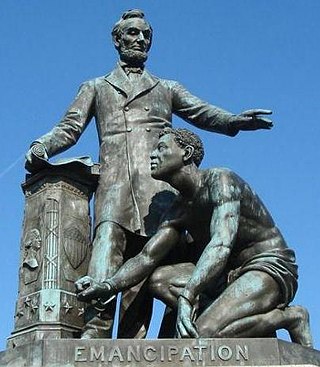
The Emancipation Memorial, also known as the Freedman's Memorial or the Emancipation Group is a monument in Lincoln Park in the Capitol Hill neighborhood of Washington, D.C. It was sometimes referred to as the "Lincoln Memorial" before the more prominent national memorial was dedicated in 1922.

Richard Henry Park was an American sculptor who worked in marble and bronze. He was commissioned to do work by the wealthy of the nineteenth century. He did a marble bust of John Plankinton, an astute businessman who founded the meat industry in Wisconsin and was "Milwaukee's foremost citizen."

Illinois Centennial Memorial Column, Logan Square Monument or Illinois Centennial Monument is a public monument in the Logan Square community area and the Chicago Landmark and National Register of Historic Places-listed Logan Square Boulevards Historic District. Built in 1918 to celebrate the 100th anniversary of Illinois' statehood, the monument, designed by Henry Bacon, famed architect of the Lincoln Memorial in Washington, DC, is a single 70-foot (21 m) tall marble Doric column topped by an eagle, in reference to the Flag of Illinois. Reliefs surrounding the base depict figures of Native Americans, explorers, farmers and laborers intended to show the great changes experienced during the state's 1st century. Although Bacon designed the main column, Evelyn Beatrice Longman designed and sculpted the reliefs.
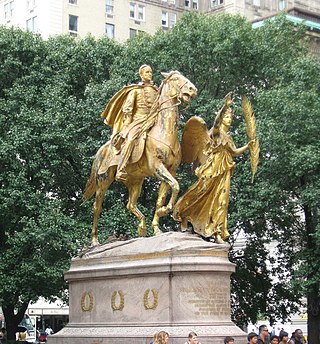
Grand Army Plaza is a square at the southeast corner of Central Park in Manhattan, New York City, at the intersection of Fifth Avenue and Central Park South, covering two blocks on the west side of Fifth Avenue between 58th and 60th Streets. It contains an equestrian statue of William Tecumseh Sherman on its northern half and the Pulitzer Fountain on its southern half.

The Elks National Veterans Memorial is a Beaux Arts-style domed building at 2750 North Lakeview Avenue in Chicago, Illinois. It is across from Lincoln Park and close to the park's Goethe Monument and statue of Alexander Hamilton.

The statue of Robert Burns in Milwaukee, Wisconsin, is a work of public art by the Scottish artist William Grant Stevenson, RSA. The statue is a memorial to the world renowned poet, bard, and Scotsman Robert Burns. The bronze statue stands upon a plinth of Nova Scotia pink granite. The plinth is adorned with two bronze bas relief panels depicting scenes from Burns' poetry. The monument was donated to the City of Milwaukee by James A. Bryden.

The Arts of War and The Arts of Peace are bronze, fire-gilded statue groups on Lincoln Memorial Circle in West Potomac Park in Washington, D.C., in the United States. Commissioned in 1929 to complement the plaza constructed on the east side of the Lincoln Memorial as part of the Arlington Memorial Bridge approaches, their completion was delayed until 1939 for budgetary reasons. The models were placed into storage, and the statues not cast until 1950. They were erected in 1951, and repaired in 1974.

Kate Sturges Buckingham (1858–1937) was an American art collector and philanthropist. She collected medieval sculpture, tapestries, and decorative arts. She is best known for her gifts to the city of Chicago, specifically the Buckingham Fountain in Grant Park, a statue honoring Alexander Hamilton in Lincoln Park, and her family's art collection to the Art Institute of Chicago.

The Alexander von Humboldt statue is a monumental statue in Chicago, Illinois, United States. Located in Humboldt Park, a major urban park in the Humboldt Park neighborhood, the statue depicts Alexander von Humboldt, a Prussian polymath and the park's namesake. The statue was dedicated in 1892.
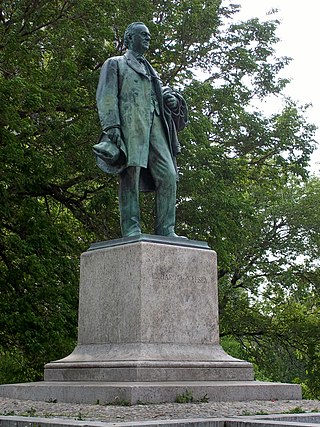
The Richard J. Oglesby statue is a monumental statue of Richard J. Oglesby in Chicago, Illinois, United States. Dedicated in 1919, the statue was designed by Leonard Crunelle and located in the city's Lincoln Park.

The Ulysses S. Grant Monument is a presidential memorial in Chicago, honoring American Civil War general and 18th president of the United States, Ulysses S. Grant. Located in Lincoln Park, the statue was commissioned shortly after the president's death in 1885 and was completed in 1891. Several artists submitted sketches, and Louis Rebisso was selected to design the statue, with a granite pedestal suggested by William Le Baron Jenney. At the time of its completion, the monument was the largest bronze statue cast in the United States, and over 250,000 people were present at the dedication.

General Alexander Macomb is a monumental statue in Detroit, Michigan, United States. It was designed by sculptor Adolph Alexander Weinman and was dedicated in 1908 in honor of Alexander Macomb, a Detroit native who had served as the Commanding General of the United States Army for several years in the early 1800s. The monument, which consists of the bronze statue of Macomb standing atop a granite pedestal on a circular concrete platform, was dedicated on September 11, on the anniversary of the Battle of Plattsburgh, a War of 1812 battle that Macomb had participated in. Since the 2010s, the statue has come under criticism due to Macomb's connections to slavery and the mistreatment of Native Americans, with several news sources publishing opinion pieces calling for the statue's removal. During the George Floyd protests in 2020, the monument was vandalized several times.
